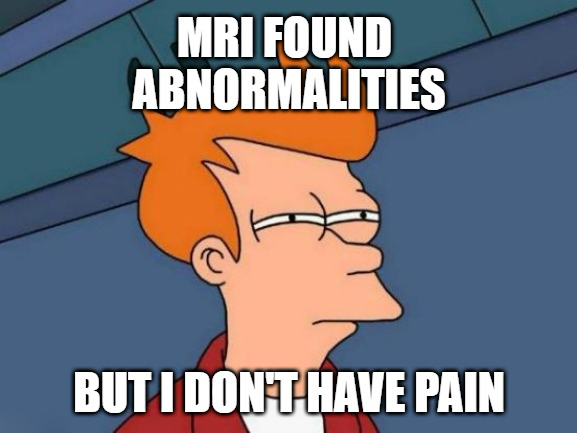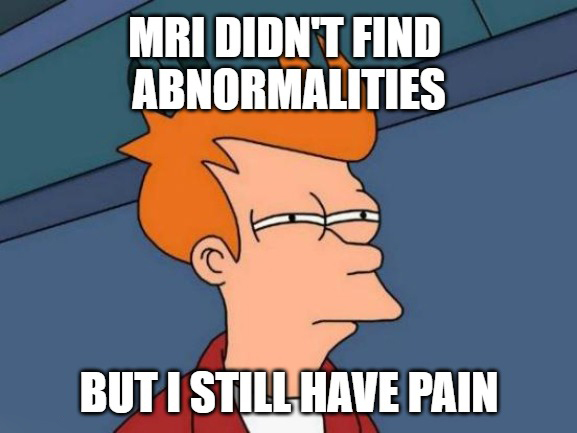MRIs: The Ninja Guide
In This Guide
The Way of MRI
An MRI is often the first step into the maze of ineffective treatments and lower quality of life.
Things You Should Know
Knowledge is power, especially when it comes to making important decisions about your health.
When MRIs are Useful
An MRI can be very useful to rule out red flags and serious conditions such as fractures or cancer.
Why MRIs are Overused
MRIs are too often ordered for reasons which have nothing to do with a legitimate medical use.
The Way of Ninja Physio
Avoid the endless maze of pain, get rid of pain for good, and come back stronger, faster, and more mobile.
Getting Peace of Mind
An MRI isn't needed to figure out most musculoskeletal injuries. What's important is a skilled team that cares.
MRIs: Gateway Into the Maze
We constantly see people sent to get MRIs that they don’t really need, wasting time and hundreds (or thousands) of dollars. The MRIs don’t provide useful information beyond what I can get myself through physical tests. They don’t change the treatment options available. Regardless of the findings, the typical options are going to be rest/avoidance, low-level physical therapy, pain pills, injections, and/or surgery.
In many cases, what the MRI does do is convince people that there’s something seriously wrong and funnel them into the endless maze of pain, with constant appointments, delays, decreasing quality of life, and years or decades of pain.
MRIs have their use, but in this guide you’ll learn why MRIs are often unnecessary, potentially counter-productive, and what to do if you want to conquer pain instead of manage pain the rest of your life.
The Way of the MRI
The endless maze of pain goes something like this:
- You have pain
- You see a doctor
- The doctor orders an MRI
- The MRI comes back with abnormal findings
- Hopefully, you get offered non-invasive treatments first (Physical therapy)
- Physical therapy doesn’t work so you’re offered increasingly invasive treatments (RFA, neurostimulator, surgery)
- Years, or decades later, you’re still in pain, stuck in this maze
It goes something like this:
Pain
Doctor(s)
Meds
MRI
Shots
PT
Ablations
Surgery
Pain Free?
The endless maze of pain, often lasting years, decades, or a lifetime.
Here’s what one of our clients went through before finally finding Ninja Physio:
Roger: MRIs, injections, and decades of pain
In his early 20’s, Roger injured his back after falling off a tank in the Army. He was in severe pain for several days, and could hardly bend over or stand up. The doctor ordered an MRI, told him that he had arthritis and a herniated disc, and gave him some pain meds and muscle relaxers to deal with it.
He managed his pain this way for several years, but then injured his back again while deadlifting. He got another MRI, which again came back positive for a herniated disc. The doctor offered him a steroid injection to reduce the pain, and also told him that he’d eventually need surgery. Roger didn’t want surgery, so he went with the injection, which eased the pain for a few months. For the next 20 years, he got injections every 3-6 months.
Since the pain would come back before he was allowed to get the next injection (due to their side effects), he also tried military physical therapy, acupuncture, the chiropractor, and massages. Some of those things helped for a bit, but he never found something that fixed it long term.
He finally gave in to the idea of having back pain the rest of his life, along with its limitations. Over time, he stopped lifting heavy weights, stopped playing basketball, and started gaining weight. He couldn’t be active himself, but he enjoyed coaching youth sports. As the pain got worse, he stopped doing that as well. He took a job as a school bus driver to keep giving back to his community, but as it became increasingly painful to get on and off the bus, he was thinking he’d have to stop doing that, too.
Luckily, he found us in time to stop and reverse that trend.
Pain can slowly, and sometimes quickly, take over your life. Many people have a similar story, and it often begins with an MRI.
Things you should know
The effectiveness and effects of MRIs have been studied extensively, and we know that:
1. Pain and MRI abnormalities are not correlated


Many people are told by their doctors that their pain is due to damage to their tissues, joints, muscles, etc, and that they need to get an MRI to find out exactly where this damage is.
This can be misleading because there is no correlation between abnormal results on an MRI and pain levels. In fact, the majority of people with no pain will have “abnormal” MRI results including arthritis, degenerative disc disease, meniscus tears, or cartilage damage.
Check out this video where doctors from the Dartmouth-Hitchcock Spine Center explain these issues regarding MRI results:

No correlation between MRI findings and low back pain in over 3,000 people
In this study, they took MRIs of over 3,000 people, and their MRI results had little to no correlation to their level of low back pain over a six year follow up. Their conclusion:
Our study shows that the MRI degenerative findings we examined, individually or in combination, do not have clinically important associations with low back pain, with almost all effects less than one unit on a 0 to 10 pain scale.
223 out of 230 people with no knee pain had abnormalities in their MRI
Here they took MRIs of 230 knees that had no pain, and 97% of them had abnormal findings on their MRI such as meniscus tears, cartilage lesions, bone marrow edema, tendon lesions, and ligament ruptures.
Nearly all knees of asymptomatic adults showed abnormalities in at least one knee structure on MRI. Meniscal tears, cartilage and bone marrow lesions of the patellofemoral joint were the most common pathological findings.
If 97% of them had abnormalities like tears, lesions, and ruptures, why didn’t they have pain?
Over 50% of people age 30+ with no pain show disc degeneration in their MRI
This study shows the prevalence of several different abnormalities in different age groups who have no low back pain. If you’re over the age of 20, there’s a 37% chance your MRI will show you have disc degeneration even if you don’t have back pain. That number jumps to 52% if you’re 30.
Imaging findings of spine degeneration are present in high proportions of asymptomatic individuals, increasing with age. Many imaging-based degenerative features are likely part of normal aging and unassociated with pain.
| Image Finding | Age | |||||
|---|---|---|---|---|---|---|
| 20 years | 30 years | 40 years | 50 years | 60 years | 70 years | |
| Disc degeneration | 37% | 52% | 68% | 80% | 88% | 93% |
| Disc height loss | 24% | 34% | 45% | 56% | 67% | 76% |
| Disc bulge | 30% | 40% | 50% | 60% | 69% | 77% |
The chance that someone will have an abnormal finding on their MRI even if they don’t have pain.
2. MRI findings can vary greatly depending on the doctor looking at them
In this study, a 63 year-old woman with a history of low back pain got 10 different MRIs at 10 different testing locations over a three-week period. The results:
- 49 different findings
- Only one finding was consistent in 9/10 MRI reports
- Some reports showed disc herniation in 5 lumbar segments, one MRI showed no disc herniation
- Central canal stenosis was present in two reports, but not present in two other reports
- Four reports showed nerve root involvement and four reports didn’t show any nerve root involvement
Where a patient obtains his or her MRI examination and which radiologist interprets the examination may have a direct impact on radiological diagnosis, subsequent choice of treatment, and clinical outcome.
So what was really going on with her? What was the cause of her back pain? Your guess might be as good as some of the doctor’s.
3. Early use of an MRI is associated with increased medical costs and unneeded procedures
This study of over 400,000 participants found that getting an MRI early was linked to a 12X increased likelihood of lumbar surgery, 20% increase in use of opioid prescriptions, and $2,500 increase in total healthcare costs.
The association between early imaging and increased utilization was apparent even in a setting largely unaffected by incentives of fee-for-service care. Early scans are associated with excess surgery, higher costs for other care, and worse outcomes, including potential harms from prescription opioids.
Here’s another systematic review that shows that getting an MRI early in the process is associated with increased medical costs and increased length of disability.
patients with acute low back pain without red flags who received eMRI had increased length of disability compared to those who did not receive eMRI.
“It is very rare for an M.R.I. to come back with the words ‘normal study’"
In this New York Times article, Dr. Andrews states, “If you want an excuse to operate on a pitcher’s throwing shoulder, just get an M.R.I.” Since the MRI is very likely to come back with abnormal findings, including damage to tendons or cartilage, a surgeon can use it to justify a procedure that may really be unneeded.
The article talks about baseball pitchers, but the same applies to anyone who is physically active; their MRI will show normal wear and tear that is of no consequence.
The article goes on to explain how there is a lot of overuse of MRIs in the medical system.
Of course, surgery is necessary sometimes. Broken bones, severe tears, and cancer might require surgery. But for many other less severe things, there’s a very good chance that you can live pain free without surgery (more on that later).
4. You’ll most likely worry regardless of the results
At the end of the day, the MRI result will come back as “normal” or “abnormal.” Either case may worry someone.
With a normal finding, someone might be worried because the doctor can’t find an alleged reason why you’re experiencing pain. Maybe it means it’s something really bad?
In the case of abnormal findings, someone might worry because the MRI confirmed that there is indeed something “wrong.” But as mentioned before, the MRI would probably find something “abnormal” even if you didn’t have pain.
5. The MRI doesn't change the options you'll be offered
The MRI won’t change the treatments offered to you. You’ll likely be lead into the endless maze of constant appointments, drugs, steroid injections, nerve ablations, neurostimulators, physical therapy, and/or surgery. It’s the same bag of tricks that often address only the symptoms and not the core issues, hence having to do them over and over for a lifetime.

When an MRI is Useful
MRIs do have their legitimate uses. We look for red flags that may indicate something more serious than a musculoskeletal issue by looking for signs, such as:
Unexplained weight loss
A fever of >102 degrees
Bowel or bladder problems
Unexplained weakness in your legs
If someone is exhibiting these symptoms, then an MRI may be a good idea to find or rule out serious conditions, such as:
fracture
cancer
infection
aneurysm
cauda equina syndrome
If someone doesn’t have these symptoms, and most people don’t, then an MRI isn’t really needed.
Why MRIs are Overused:
Outdated Training, Bean Counters, and Lawsuits
If MRIs aren’t necessary in so many cases, and they can lead to worse outcomes and more expensive procedures, why are they used so much?
A doctor may order an MRI that’s not really necessary due to:
Outdated training: It’s how they were trained in school a while back and they haven’t stayed up to date with the latest knowledge.
Patient satisfaction: A patient requests an MRI, and the doctor orders it just to satisfy them.
Insurance: Some insurance companies require an MRI before approving certain procedures.
CYA: Extensive testing can help a doctor create a stronger defense in case a patient sues.
Revenue: Some doctors own their own machines or are pressured by the hospital they work for to order MRIs to increase revenue.
The Way of Ninja Physio
This is what the path looks like at Ninja Physio:
Pain
Ninja Physio
Pain Free
Come Back Stronger
And here’s what it’s like in real life:
Patrick: Emergency room to salsa dancing in six weeks
Patrick injured his lower back deadlifting at the gym. He first went to urgent care, waited for five hours to get an X-ray and an injection in his hip, then went to a low-cost chiropractor which only made it worse. His pain was so bad he could barely walk, couldn’t sleep, and couldn’t work.
After a few days in excruciating pain, he did a local search and found us. We scheduled him for the next day. He signed up for the program, and after six weeks he was back to scuba diving, horseback riding, and deadlifting correctly and confidently.
While he was going through his Ninja program, he was also waiting to be seen by the VA. Several weeks into his program, his MRI came back positive for a disc herniation, but it didn’t bother him because we had already diagnosed it and he was largely pain free.
After he had completed his program with us, the VA was referring him to neurology for a surgery consultation, but he decided not to go because he was already pain free and back to living.
Did you notice how simple and non-contrived that was? That’s what happens when you work with a skilled and caring team that puts people first. There’s no months of waiting, no approvals needed, no invasive procedures, no drawn-out treatment plans, and no endless mazes.
Peace of Mind
For many, MRIs are really about peace of mind. There’s something about having a high-tech machine look inside to detect what a human seemingly can’t. It takes a complex machine to figure out a “complex” problem, right? At face value it makes sense, but as we’ve seen above, it’s not really the case with musculoskeletal issues.
Worried about red flags?
Most red flags (cancer, fracture, aneurysm, etc) can be ruled out by asking simple questions or performing simple tests. As for musculoskeletal pain, if you weren’t in a serious accident or you’re not in excruciating pain (can’t walk), you most likely don’t need an MRI, and don’t need surgery. Many findings on MRI results (meniscus tears, disc herniation) can also be diagnosed by a physio by performing physical tests.
The doctors haven’t helped much?
If doctors haven’t been able to get rid of the pain long term, odds are it’s not because of insufficient MRIs. Something to keep in mind is that the system has more to gain by maintaining and managing pain than than by solving the core issues and getting rid of the pain for good. It’s sad, and it shouldn’t be this way, but that’s what it’s become.
As we’ve seen over and over, there is a long-term solution to pain that doesn’t involve medications, injections, surgery, and a lifetime of appointments. You don’t have to keep your time, money, health, and life. … If you want real solutions that aren’t wasting your time, money, health, and life, you’ll need to think outside the system.
If You're Getting an MRI
Now, more than ever, you must take your health into your own hands and ask lots of questions. You should now be armed with the knowledge to help you take control of your health. Remember this as you’re you’re being nudged into the endless maze of pain:
It's very likely that the "abnormal" findings on the MRI aren't the reason you're having pain.
MRI findings are frequently used to justify unneeded, invasive, and expensive procedures that often don’t address the core issues.
There is a long-term solution to most musculoskeletal pain, and it doesn't involve pain pills, injections, invasive procedures, or surgery.
If you want real solutions that aren’t wasting your time, money, health, and life, you’ll need to think outside the system.
We’ve proven that there’s a long-term solution to pain that doesn’t involve medications, injections, invasive procedures, surgery, or a lifetime of appointments. It’s called Ninja Physio.
Get Answers to Your Questions.
Navigating the maze of pain can be very confusing. If you’re thinking of getting an MRI, or already got one and not sure what the best next step is, we’re happy to go over your situation and options with you.
